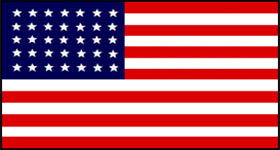Civil War Battles |
Colonial Wars |
American Wars |
Link To This Page — Contact Us —
The Battle of Fair Gardens
January 27, 1864 in Sevier County, Tennessee
Union Forces Commanded by:
Brig. Gen. Samuel D. Sturgis and Col. Edward M. McCook
Brig. Gen. Samuel D. Sturgis and Col. Edward M. McCook
| Forces | Killed | Wounded | Captured |
| - | 100 k&w | - | - |
Confederate Forces Commanded by:
Maj. Gen. William T. Martin
| Forces | Killed | Wounded | Captured |
| - | 60 | 0 | 100* |
**Missing and Captured
Conclusion: Union Victory

BATTLE SUMMARY
Ordered to push Lt. Gen. James Longstreet's Confederates north from their east Tennessee winter quarters at russellville and morristown, maj. Gen. John G. Foster's Union cavalry began inneffective operations south of the French Broad river in january. Foster's cavalry, led by Brig. Gen. Samuel D. Sturgis, saw only 3 days of significant fighting. Since the Battle of Dandridge, the Union cavalry had moved to the south side of the French Broad River and had disrupted Confederate foraging and captured numerous wagons in that area. On January 25, Longstreet, commander of the Department of East Tennessee, instructed his subordinates to do something to curtail Union operations south of the French Broad.On the 26th, Brig. Gen. Samuel D. Sturgis, having had various brushes with Confederate cavalry, deployed his troopers to watch the area fords. Two Confederate cavalry brigades and artillery advanced from Fair Garden in the afternoon but were checked about 4 miles from Sevierville. Other Confederates attacked a Union cavalry brigade, though, at Fowler's on Flat Creek, and drove it about 2 miles. No further fighting occurred that day. Union scouts observed that the Confederates had concentrated on the Fair Garden Road, so Sturgis ordered an attack there in the morning. In a heavy fog, Col. Edward M. McCook's Union division attacked and drove back Maj. Gen. William T. Martin's Confederates until about 4:00 P.M. At that time, McCook's men charged with sabers and routed the Confederates.
The depth of the Confederate disorganization was clear the next day. Sturgis set out in pursuit on the 28th, and captured and killed more of the routed Confederates. Had Confederate morale and leadership been better, the troops would have rallied overnight, rather than looking for warm places overnight. The Union forces, however, observed 3 of Longstreet's infantry brigades crossing the river. Realizing his weariness from fighting, lack of supplies, ammunition, and weapons and the overwhelming strength of the enemy, Sturgis decided to evacuate the area. Yet the aggressiveness of the good cavalry commander bubbled in his veins. But, before leaving, Sturgis determined to attack Brig. Gen. Frank C. Armstrong's Confederate cavalry division which he had learned was about three or four miles away, on the river.
Unbeknownst to the attacking Federals, Sturgis only had partial information. Armstrong had strongly fortified his position and 3 infantry regiments had arrived to reinforce him. Thus, the Union troops suffered severe casualties in the attack. Yet Sturgis’ men kept fighting until dark, and were strong enough that Armstrong didn’t sortie from his positions and overrun isolated portions. The battle continued until dark, when the Federals retired from the area. The Federals had won the big battle but the fatigue of continual fighting and lack of supplies and ammunition forced them to withdraw.
